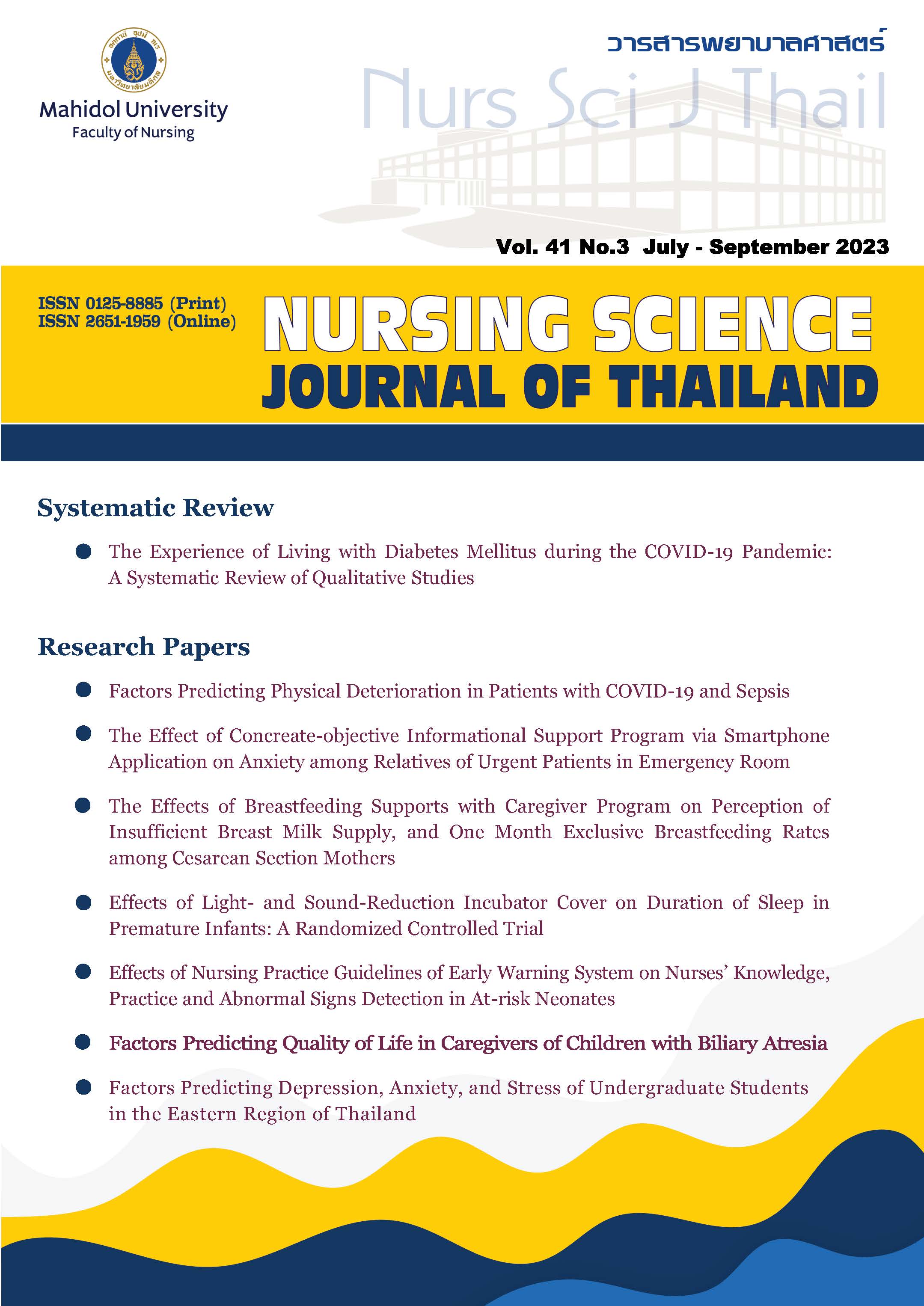ปัจจัยทำนายภาวะซึมเศร้า วิตกกังวล และความเครียดของนักศึกษาระดับปริญญาตรี ในภาคตะวันออกของประเทศไทย
Main Article Content
บทคัดย่อ
วัตถุประสงค์: เพื่อศึกษาความชุกและปัจจัยทำนายภาวะซึมเศร้า วิตกกังวล และความเครียด ของนักศึกษาระดับปริญญาตรี ในภาคตะวันออกของประเทศไทย
รูปแบบการวิจัย: การศึกษาความสัมพันธ์เชิงทำนาย
วิธีดำเนินการวิจัย: กลุ่มตัวอย่างเป็นนักศึกษาระดับปริญญาตรีจำนวน 400 คนจากมหาวิทยาลัยแห่งหนึ่ง ในภาคตะวันออกของประเทศไทย กลุ่มของสาขาวิชาและคณะภายใต้กลุ่มสาขาวิชาถูกจัดแบ่งเป็นชั้นภูมิและสุ่มเลือกมา 6 คณะ นักศึกษาที่มีคุณสมบัติเป็นกลุ่มตัวอย่างถูกเลือกเข้ามาด้วยวิธีการเลือกแบบสะดวก เครื่องมือวิจัยประกอบด้วย 1) แบบสอบถามข้อมูลส่วนบุคคล 2) แบบสอบถามภาวะซึมเศร้า วิตกกังวล และความเครียด และ 3) แบบสอบถามความยากในการกำกับอารมณ์ วิเคราะห์ข้อมูลโดยใช้การวิเคราะห์ถดถอยโลจิสติคทวิ
ผลการวิจัย: พบว่านักศึกษามีภาวะซึมเศร้า วิตกกังวล เครียด ในระดับรุนแรงถึงรุนแรงมากคิดเป็นร้อยละ 20.7, 32.2 และ 15.4 ตามลำดับ ปัจจัยที่ทำนายภาวะซึมเศร้าอย่างมีนัยสำคัญทางสถิติ ได้แก่ ความยากในการกำกับอารมณ์ (p < .001) ปัจจัยที่ทำนายภาวะวิตกกังวลอย่างมีนัยสำคัญทางสถิติ ได้แก่ ความยากในการกำกับอารมณ์ (p < .001) และการมีประวัติการเจ็บป่วยทางกาย (p < .05) และปัจจัยที่ทำนายภาวะเครียดอย่างมีนัยสำคัญทางสถิติ ได้แก่ ความยากในการกำกับอารมณ์ (p < .001) การมีประวัติการเจ็บป่วยด้านจิตใจ (p < .05) และการมีเหตุการณ์ที่ก่อให้เกิดความเครียด (p < .001)
สรุปและข้อเสนอแนะ: นักศึกษามากกว่าร้อยละ 15 ของจำนวนนักศึกษาทั้งหมด ประสบกับภาวะอารมณ์ทางลบ ได้แก่ ซึมเศร้า วิตกกังวล และความเครียดในระดับรุนแรง ซึ่งปัจจัยที่สามารถทำนายภาวะอารมณ์ทางลบดังกล่าวอย่างมีนัยสำคัญทางสถิติคือ ความยากในการกำกับอารมณ์ ผลการวิจัยมีข้อเสนอแนะให้สถาบันการศึกษาควรมีการคัดกรองภาวะสุขภาพจิตของนักศึกษาเป็นระยะๆ และมีบริการการให้คำปรึกษาที่มีประสิทธิภาพ เพื่อช่วยเหลือนักศึกษาในการจัดการกับภาวะทุกข์ทางอารมณ์และการปรับตัวในการดำเนินชีวิตในรั้วมหาวิทยาลัย
Article Details

This work is licensed under a Creative Commons Attribution-NonCommercial-NoDerivatives 4.0 International License.
ลิขสิทธิ์: วารสารพยาบาลศาสตร์เป็นเจ้าของลิขสิทธิ์ในการเผยแพร่ผลงานที่ตีพิมพ์ ห้ามผู้ใดนำบทความที่ได้รับการตีพิมพ์ในวารสารพยาบาลศาสตร์ไปเผยแพร่ในลักษณะต่างๆ ดังต่อไปนี้ การส่งบทความไปตีพิมพ์เผยแพร่ที่อื่น การนำบทความเผยแพร่ออนไลน์ การถ่ายเอกสารบทความเพื่อกิจกรรมที่ไม่ใช่การเรียนการสอน ยกเว้นเสียแต่ได้รับอนุญาตจากวารสารพยาบาลศาสตร์

Disclaimer: เนื้อหาบทความหรือข้อคิดเห็นใดๆ ในวารสารพยาบาลศาสตร์ ถือเป็นความรับผิดชอบของผู้เขียน กองบรรณาธิการไม่จำเป็นต้องเห็นด้วยและไม่มีส่วนรับผิดชอบแต่อย่างใด
References
Hernández-Torrano D, Ibrayeva L, Sparks J, Lim N, Clementi A, Almukhambetova A, et al. Mental health and well-being of university students: a bibliometric mapping of the literature. Front Psychol. 2020;11:1226. doi: 10.3389/fpsyg.2020.01226.
Solmi M, Radua J, Olivola M, Croce E, Soardo L, Salazar de Pablo G, et al. Age at onset of mental disorders worldwide: large-scale meta-analysis of 192 epidemiological studies. Mol Psychiatry. 2022;27(1):281-95. doi: 10.1038/s41380- 021-01161-7.
Chootong R, Wiwattanaworaset P, Buathong N, Noofong Y, Chaithaweesup P, Cheecharoen P, et al. Mental health status, family state and family functioning of undergraduate students in a southern university, Thailand. J Psychiatr Assoc Thailand. 2019;64(4):337-50. (in Thai).
Lun KWc, Chan CK, Ip PKy, Ma SYk, Tsai WW, Wong CS, et al. Depression and anxiety among university students in Hong Kong. Hong Kong Med J. 2018;24(5):466–72. doi: 10.12809/hkmj176915.
Engel GL. The need for a new medical model: a challenge for biomedicine. Science. 1977;96(4286):129-36. doi: 10.1126/science.847460.
Schäfer JÖ, Naumann E, Holmes EA, Tuschen-Caffier B, Samson AC. Emotion regulation strategies in depressive and anxiety symptoms in youth: a meta-analytic review. J Youth Adolesc. 2017;46(2):261–76 .doi: 10.1007/s10964-016-0585-0.
Mofatteh M. Risk factors associated with stress, anxiety, and depression among university undergraduate students. AIMS Public Health. 2020;8(1):36–65. doi: 10.3934/publichealth.2021004.
Ramón-Arbués E, Gea-Caballero V, Granada-López JM, Juárez-Vela R, Pellicer-García B, Antón-Solanas I. The prevalence of depression, anxiety and stress and their associated factors in college students. Int J Environ Res Public Health. 2020:17(19):7001. doi: 10.3390/ijerph17197001.
Cao W, Fang Z, Hou G, Han M, Xu X, Dong J, et al. The psychological impact of the COVID-19 epidemic on college students in China. Psychiatry Res. 2020;287:112934. doi: 10.1016/j.psychres.2020.112934.
Pramukti I, Strong C, Sitthimongkol Y, Setiawan A, Pandin MGR, Yen CF, et al. Anxiety and suicidal thoughts during the COVID-19 pandemic: cross-country comparative study among Indonesian, Taiwanese, and Thai university students. J Med Internet Res. 2020;22(12):e24487. doi: 10.2196/24487.
Vatanasin D, Hengudomsub P, Vatanasin S, Asarath T, Chupan S, Srisopa P. Factors predicting depression among health science students. The Journal of Faculty of Nursing Burapha University. 2015;23(4):31-47. (in Thai).
Kaewmart N, Koedbangkham J, Nabkasorn C. Factors influencing depression among nursing students of burapha university. The Journal of Faculty of Nursing Burapha University. 2011;18 Suppl 2:83-95. (in Thai).
Hair JF, Black WC, Babin BJ, Anderson RE. Multivariate data analysis. 8th ed. Hampshire, UK: Cengage Learning; 2018. 813 p.
Kaufman EA, Xia M, Fosco G, Yaptangco M, Skidmore CR, Crowell SE. The difficulties in emotion regulation scale short form (DERS-SF): validation and replication in adolescent and adult samples. J Psychopathol Behav Assess. 2016;38(3):443–55. doi: 10.1007/s10862-015-9529-3.
Beaton DE, Bombardier C, Guillemin F, Ferraz MB. Guidelines for the process of cross-cultural adaptation of self-report measures. Spine (Phila Pa 1976). 2000;25(24):3186–91. doi: 10.1097/00007632-200012150-00014.
Srisopa P, Moungkum S, Hengudomsub P, Sirikit R. Psychometric properties of difficulties in emotion regulation scale – short form Thai version in university students [research report]. Chonburi: Faculty of Nursing Burapha University; 2022. 18 p. (in Thai).
Lovibond PF, Lovibond SH. The structure of negative emotional states: comparison of the depression anxiety stress scales (DASS) with the beck depression and anxiety inventories. Behav Res Ther. 1995;33(3):335–43. doi: 10.1016/0005-7967(94)00075-U.
Oei TPS, Sawang S, Goh YW, Mukhtar F. Using the Depression Anxiety Stress Scale 21 (DASS-21) across cultures. Int J Psychol. 2013;48(6):1018–29. doi: 10.1080/00207594.2012.755535.
Rahman MM, Asikunnaby, Khan SJ, Arony A, Mamun Z Al, Procheta NF, et al. Mental health condition among university students of Bangladesh during the critical COVID-19 period. J Clin Med. 2022;11(15):4617. doi: 10.3390/jcm11154617.
Thompson RA. Emotion and emotion regulation: two sides of the developing coin. Emot Rev. 2011;3(1):53–61. doi: 10.1177/1754073910380969.
Bodell LP, Pearson CM, Smith KE, Cao L, Crosby RD, Peterson CB, et al. Longitudinal associations between emotion regulation skills, negative affect, and eating disorder symptoms in a clinical sample of individuals with binge eating. Eat Behav. 2019;32:69–73. doi: 10.1016/j.eatbeh.2018.12.005.
Bradley B, DeFife JA, Guarnaccia C, Phifer J, Fani N, Ressler KJ, et al. Emotion dysregulation and negative affect: association with psychiatric symptoms. J Clin Psychiatry. 2011;72(5):685–91. doi: 10.4088/JCP.10m06409blu.
Carpenter RW, Trull TJ. Components of emotion dysregulation in borderline personality disorder: a review. Curr Psychiatry Rep. 2013;15(1):335. doi: 10.1007/s11920-012-0335-2.

